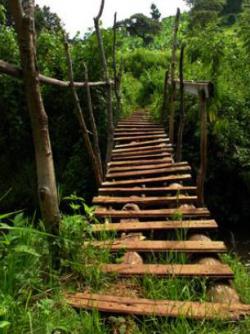Serendip is an independent site partnering with faculty at multiple colleges and universities around the world. Happy exploring!
rickety-rackety bridge, #360lyfe

[NOTE: I spent a half an hour trying to resize my desired image so I could change my avatar and, since I'm currently on a windows computer that I don't know how to use, I couldn't figure it out. So I'm posting the image here and I'll work on changing it later tonight.]
For the last 360 I was in, my first interaction with Serendip, this was my avatar picture:
This is a picture of myself being strong and using my voice, and I chose it because I felt it represented myself and my activism and my power. I almost didn't change the picture for this semester, because I like this one so much, but I realized that this no longer represents where I am. I am not the same person I was at the beginning of that semester, because it was such a transformational experience for me. Today in class, with all the discussion about language and reading and words and communication and different understandings, backgrounds and experiences, I was reminded of a metaphor that has stayed with me ever since the end of the Women in Walled Communities 360.
I've been trying to find the exact quote, wich is difficult because the idea I want to use started with Peggy Phelan and was used and added to by Elizabeth Ellesworth who has been quoted by many others, though in the small amount of research I've done in the past hour, I haven't been able to find any solid academic sources (sorry!). But here's the general idea: Phalen described "the rackety bridge between self and other", which Ellsworth claims is where teaching and learning happens. I've put myself on this bridge many times, out of a desire to learn and grow and make change in the world, and after our fieldtrip to Camden, I realized that once again, I was back in that terrifying, uncomfortable, exciting, rich place; out of my element, an outsider in a different world. And as "stra nge" and "unnatural" as it feels, it also feels right. ("All things natural are strange")
nge" and "unnatural" as it feels, it also feels right. ("All things natural are strange")
Because I have realized over the past year or two, through many experiences of 'the other', that this is what I want to do with my life, that I want to face the rickety bridge and walk across it, even knowing that I will never quite get to the other side, that I will never fully understand the other.
I was looking back on where I left of on Serendip, my final posts in December, and I found that my last post, my self evaluation, had a great picture in it. And so I'm picking up where I left off. Of course I've had transformative experiences since then - my life has continued on outside of serendip - but this metaphor/image still greatly applies to my life and my hopes for this 360. #360LYFE


Comments
the marvelous on-line archive that is Serendip...
has your quote (@ least @ the second level....) See samuel.terry's The Personal Echoes. Will you respond?:
... in Teaching Positions: Difference, Pedagogy, and the Power of Address [Elizabeth Ellsworth] argues that there will always be a gap between the knowledge, (which itself is partial ...) that the teacher wishes to impart and what the student absorbs. An extraordinarily powerful metaphor for the experience of teaching and learning as a suspended performance is that of the shaky bridge. Ellsworth writes,
“we pitch our teaching into an abyss between self and self, self and other. And yet something, and hopefully not a repetitive echo, but an inquisitive, ironic echo—a difference that makes a difference—returns […] On this bridge, teaching might come to mean something more that standing nearby another as we both face the abyss, and getting curious about what suspended performance each of us might make so that each of our passions for learning might be entertained here” (159).
The original quote is from Peggy Phelan (and was cited by Megan Sweeney in Reading is my Window, which is probably where you encountered it):
"It is is the attempt to walk (and live) on the rickety bridge between self and other--and not the attempt to arrive at the other--that we discover real hope. That work is our always suspended performance, in the classroom, in the political field, in relation to one another and ourselves" (250-251).
Thank you!
this is exactly it!